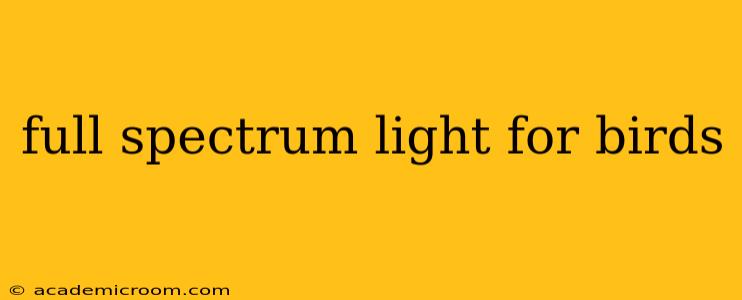Full spectrum lighting is becoming increasingly popular among bird keepers, promising a healthier and happier life for their feathered friends. But what exactly is full spectrum light, and does it truly benefit birds? This comprehensive guide delves into the science behind full spectrum lighting, its potential advantages, and considerations for its proper use. We'll explore the nuances of choosing the right bulb, addressing common concerns and misconceptions along the way.
What is Full Spectrum Lighting?
Full spectrum lighting aims to mimic natural sunlight, providing a broader range of wavelengths than standard incandescent or fluorescent bulbs. Natural sunlight contains ultraviolet (UV) rays, visible light, and infrared (IR) radiation. While traditional lighting often focuses primarily on visible light, full spectrum bulbs attempt to replicate the entire spectrum, including the beneficial UV-A and visible light wavelengths. UV-B is generally less critical for pet birds, as it’s typically filtered out by glass and window panes.
Why is Full Spectrum Light Important for Birds?
Birds rely on light for a variety of biological processes. Let's explore the key benefits:
Improved Vitamin D3 Production: Exposure to UV-A light helps birds synthesize Vitamin D3, crucial for calcium absorption and strong bones. A deficiency can lead to metabolic bone disease (MBD), a serious and potentially fatal condition.
Enhanced Mood and Behavior: Full spectrum lighting can help regulate birds' circadian rhythms, promoting natural sleep-wake cycles and reducing stress. This can lead to improved mood, increased activity, and healthier behaviors.
Brighter Plumage: While not definitively proven for all bird species, some bird keepers report that full spectrum lighting enhances the vibrancy and brightness of their birds' plumage.
Stimulated Breeding: In some species, full spectrum lighting can mimic the increased daylight hours associated with breeding seasons, potentially stimulating breeding behavior. However, this should be approached cautiously and with a thorough understanding of the specific needs of your bird species.
What are the Different Types of Full Spectrum Bulbs?
Several types of bulbs offer full-spectrum lighting, each with pros and cons:
-
Compact Fluorescent Lamps (CFLs): Relatively inexpensive and energy-efficient, but can produce less intense light and have a shorter lifespan than other options.
-
Light Emitting Diodes (LEDs): Becoming increasingly popular due to their long lifespan, energy efficiency, and ability to accurately reproduce specific wavelengths of light. However, they can be more expensive upfront.
-
Metal Halide Lamps: Offer very high light output and accurate color rendering, but are typically more expensive and require specialized ballasts.
How Much Full Spectrum Light Do Birds Need?
The optimal amount of full spectrum light varies depending on the species and individual bird. Generally, 10-12 hours of full spectrum light per day is considered adequate for most pet birds. However, always research the specific needs of your bird's species. Observe your bird's behavior. If they seem lethargic or excessively sleepy, consider adjusting the lighting schedule.
What are the potential downsides of full spectrum lighting?
While generally safe, overexposure to full spectrum light can potentially lead to issues. Avoid placing the light too close to the bird, causing overheating. Monitor your bird closely for any signs of stress or discomfort.
Can full spectrum lighting cure or prevent MBD?
Full spectrum lighting is a supportive measure, not a cure for metabolic bone disease. It aids Vitamin D3 synthesis, but MBD also often requires dietary adjustments and veterinary care.
How to choose the right full spectrum bulb for my bird?
Consider your bird's species, cage size, and desired light intensity when choosing a full spectrum bulb. Research the specific requirements of your bird and consult with an avian veterinarian for personalized advice.
Can I use a grow light for my bird?
While some grow lights offer full spectrum output, they are often designed for specific plant needs and may not be ideal for birds. Choose lights specifically marketed for bird use to ensure optimal wavelength ranges and safety.
This guide provides a starting point for understanding the role of full spectrum lighting in bird care. Remember that responsible bird ownership requires a holistic approach, combining proper nutrition, enrichment, and veterinary care with appropriate lighting. Always consult with an avian veterinarian for species-specific advice and to address any concerns about your bird's health.
